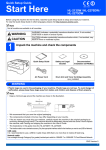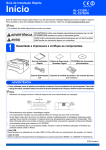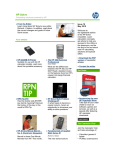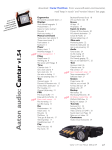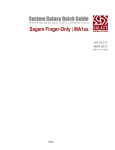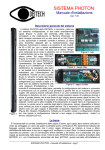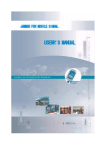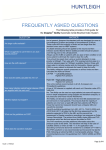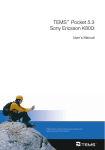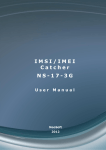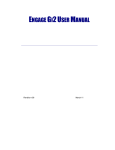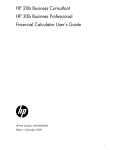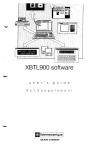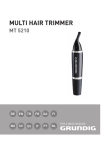Download Traffic location in mobile cellular telecommunications systems
Transcript
US 20010016490A1 (19) United States (12) Patent Application Publication (10) Pub. No.: US 2001/0016490 A1 (43) Pub. Date: Martin-Leon et al. (57) (54) TRAFFIC LOCATION IN MOBILE CELLULAR TELECOMMUNICATIONS SYSTEMS (76) Inventors: Silvia Martin-Leon, SWindon (GB); Mustafa Ahmed, Woking (GB); Timothy David Hurley, SWindon (GB) ABSTRACT In order to automate the process of locating “hot-spots” in an eXisiting mobile cellular telecommunications system, With a vieW to installing neW BTS, a method for assessing traf?c density comprises: providing a test transmitter, and moving it to one or more selected sites Within existing cells of the sys Correspondence Address: Docket Administrator (Room 3C-512) Lucent Technologies inc. tem; the transmitter transmitting test signals to mobile stations Within its vicinity, the mobile sta 600 Mountain Avenue PO. Box 636 tions Within the vicinity transmitting ?rst signal Murray Hill, NJ 07974-0636 (US) mobile stations transmitting second signal strength strength response signals to said test signals, and said (21) Appl. No.: 09/737,689 (22) Filed: Dec. 15, 2000 (30) Aug. 23, 2001 response signals to corresponding test signals from base stations of associated cells; and analyzing received ?rst and second response sig nals for assessing traf?c density Within the vicinity of the transmitter, comprising analyzing the received ?rst signal strength response signals to determine Foreign Application Priority Data Dec. 21, 1999 (EP) ...................................... .. 993103530 those ?rst response signals Which are greater than a predetermined threshold value, and comparing those Publication Classi?cation ?rst response signals Which are greater than a pre (51) Int. Cl.7 ..................................................... .. H04Q 7/20 (52) US. Cl. .. 455/424; 455/453; 455/67.1; 455/423 determined threshold value With the second signal strength response signals to determine the value of the ?rst response signals in relation to the second response signals. Patent Application Publication Aug. 23, 2001 Sheet 1 0f 13 W l A“b~i14s U US 2001/0016490 A1 Patent Application Publication Aug. 23, 2001 Sheet 3 of 13 ( Start US 2001/0016490 A1 ) V 0.1 Open program main display window I 0.2 Wait for the user to seiect data txt file 0.3 is the user wante to start the calculation 9 0.4 is the data entered 0.5 Display error message from user vaiid ? ( 0.6 Gotot ) v 0.7 Save the results in the output file Patent Application Publication Aug. 23, 2001 Sheet 4 of 13 € US 2001/0016490 A1 0.8 is it the first set of results ? Yes 0.9 Compare the current results with other sets of results I 0.10 Display the results in order according to the user’s choice 0.11 ls No the user wanted to exit? 0.12 Close the window W 1 F, Finish 3(contd.) ) Patent Application Publication Aug. 23, 2001 Sheet 5 of 13 US 2001/0016490 A1 FIG. 4 1 Algorithm 1 ) I 1.1 lnitialise Counters to 0 I 1.2 tnitialise list of logical channel elements to O I 1.3 Read and store the user's input data I 1.4 Read Abis (*.txt) file I 1.5 Search Abis file for ‘ event which has "Measurement Result" No 1.6 Is event found ? 1.19 11 "Measurement Resu't" Extract and Store data from event not found' GO ID END PROCEDURE Abis tile measurement <———‘ Patent Application Publication Aug. 23, 2001 Sheet 6 0f 13 US 2001/0016490 A1 1.8 ls time before start time ? 1.9 is time after finish time ? Yes 1.10 increment "total no. of measurements" counter 1.11 Does channel of measurement already exist 1.12 Found Channel = Current Channel‘ 1.13 Create new Channel in list New Channel = Current Channel FIG. 4(contd.) _l_ _ _ _ _ _ _ _ _ _ _ _ _ _.__V___ Patent Application Publication Aug. 23, 2001 Sheet 7 0f 13 .Ilua' i. lk e: 22“5 2 85 5? 906up;N mp; 68523552ua2: US 2001/0016490 A1 2.;206m GE5 % up; 0Ewc26“5LmF0ocE.5SwmE EmnES:m E695h=E:0moSw E.muwni zE: Patent Application Publication Aug. 23, 2001 Sheet 8 of 13 US 2001/0016490 A1 FIG. 5 2.1 Is measurement number > 0 ls Current Channel "no. of last measurement“ 2.2 Update Channel data A I 2.4 Update Channel data B Current Channel "time of last measurement“ > 700 mSec ? l \' 2.7 Update 2.6 Update Channel dataA Channel data B u l Finish < ) Channel data A: ' "No. of RXLEV measurements above threshold" = “no. of RXLEV measurements above threshold + current channel " last measurement on threshold“ '“No. of RXLEV measurements of best server" = "no. of RXLEV measurements of best server " + current channel " last measurement of best server" Channel data B: ' Current Channel " last measurement on threshold " = O 0 Current Channel " last measurement of best server " = 0 Patent Application Publication Aug. 23, 2001 Sheet 9 0f 13 US 2001/0016490 A1 FIG. 6 ( Algorithm 3 l '_l , . for each neighbourcell I 3.1 fori=1to6 V 3.4 Go to next V neighbour cell i Test Transmitter values ’ / are taken from Test Transmitter dialog box neighbour cell i N60, 800 and BCCR .__I index (it used) = Test Transmitter NCC, BCCH and BCCH index 3.5 Test Transmitter found = TRUE Threshold level value“ ,'input from Test 3.6 ' Is neighbour cell i (RXLEV-l 10 + correction factor) >= threshold level? lrinsmitter dialog box Patent Application Publication Aug. 23, 2001 Sheet 11 0f 13 US 2001/0016490 A1 68mm”;6n2% I 5 51ea2.":2Pm.62 su 2dE8.2 E352.o#_:5:062n568 Eas_52E#c25632u085’$: $52“; % ~ u.m2“:5523 E2 . .5wt% Patent Application Publication Aug. 23, 2001 Sheet 12 0f 13 US 2001/0016490 A1 FIG. 7 Algorithm 4 N0 4.1 Is Test Transmitter best server =TRUE? V 4.2 Current Channel "last measurement of best server'=0 YES (boolean FALSE value) 4.6 incrementi 4.5 Is neighbour cell 1 (FlXLEV + correction factor) > neighbour cell i RXLEV? Yes 4.7 Test Transmitter best server = FALSE 4.8 > Exit for] = t to 6 loop ..... _-_________-_l_-_____ Patent Application Publication Aug. 23, 2001 Sheet 13 of 13 US 2001/0016490 A1 4.9 ls Test Transmitter best sewer =TRUE? I 4.11 Current Channel "last measurement of best server'=0 (boolean FALSE value) 4.10 Increment "no of best server measurements " counter Current Channel ' last measurement of best server "=1 (boolean TRUE value) I ( ' Finish ) % of Test Transmitter RXLEV measurements above threshold = 100 * no. of RXLEV I measurements above threshold \ total no. of measurements. Call time in Test Transmitter RXLEV above threshold = no. of RXLEV measurements END PROCEDURE < above threshold * 0.48 seconds. ' % of Test Transmitter RXLEV measurements are the best server = 100 * no. of RXLEV measurements of best server \ total no. of measurements. ' Call time in Test Transmitter are the best server = no. of RXLEV measurements of the best server * 0.48 seconds. Fl 7(contd. ) Aug. 23, 2001 US 2001/0016490 A1 TRAFFIC LOCATION IN MOBILE CELLULAR TELECOMMUNICATIONS SYSTEMS [0012] a test transmitter means, movable to one or more selected sites Within existing telecommunica tions cells and arranged to transmit test signals to mobile stations Within its vicinity; Which mobile stations are arranged to transmit ?rst response sig nals to said test signals; CROSS-REFERENCE TO RELATED APPLICATION [0001] This application claims priority of European Patent Application No. 993103530, Which Was ?led on Dec. 21, 1999. [0002] The present invention relates to the location of traf?c, in particular regions of increased traf?c density, in [0013] and means for analyZing received ?rst response signals, in addition to received second response signals to corresponding test signals from base stations of associated cells, for assessing traf?c density Within the vicinity of the transmitter means. mobile cellular telecommunications systems. [0014] The present invention is particularly preferred for [0003] When a neW netWork operator is licensed and the netWork designed, the radio base stations are usually planned on the basis of providing maximum coverage With relatively loW traf?c capacity. In this Way, the neW service is made available to the maximum number of possible con sumers, as rapidly as possible, While minimiZing the initial capital outlay. The radio netWork planning at this stage is satisfactorily performed With a combination of manual ?eld strength surveys from test transmitters, and automatic cov erage prediction and frequency assignment softWare. [0004] Once the new networks subscriber base groWs, it becomes necessary to add traf?c capacity, often in the form of additional base station sites. It is at this stage that it is necessary to identify areas of traf?c congestion, and target the provision of neW base station sites in these areas. Thus, the location of regions of increased traf?c density or “hot use With the GSM system, but other systems may be employed for example UMTS, AMPS, TACS, NMT, etc. In the speci?cation beloW, Where acronyms are used Without an explanation, they have the meaning assigned to them by the relevant ETSI standards for the GSM system. [0015] In accordance With the invention, a transmitter of loW poWer is used, so that only mobile stations (MS) in the vicinity of the transmitter detect the signal. The nature of the test signal Will naturally depend on the type of mobile system in Which the invention is used, since the test signals must be compatible With those received by existing base transceiver stations (BTS). As preferred, the test signal is such that the mobile stations make signal strength reports, constituting said ?rst response signals, at regular intervals of the type used for handover operations betWeen cells. HoW ever the response signals may comprise other parameters, as spots” is an important problem, particularly for the siting of for example the signal delay betWeen signals transmitted base transceiver stations (BTS) to accommodate the traf?c. from a BTS and received by a mobile station. Many such “hot spots” can be identi?ed by careful analysis of geographical/morphological data and good knoWledge of the area. HoWever, there remains a great interest in the automation of such process. [0005] It is an object of the present invention to provide a method and means for automatically assessing the traf?c density in geographical regions in a mobile cellular tele communications system. [0006] In a ?rst aspect, the present invention provides a method for assessing traf?c density in a mobile cellular telecommunications system, the method comprising: [0007] providing a test transmitter means, and mov ing it to one or more selected sites Within existing cells of the system; [0008] the transmitter means, at the or each site, transmitting test signals to mobile stations Within its vicinity, [0009] the mobile stations Within the vicinity trans mitting ?rst response signals to said test signals, and said mobile stations transmitting second response signals to corresponding test signals from base sta tions of associated cells; [0010] and analyZing received ?rst and second response signals for assessing traffic density Within the vicinity of the transmitter means. [0011] In a second aspect, the present invention provides apparatus for assessing traf?c density in a mobile cellular telecommunications system, comprising: [0016] The present invention may be used for different purposes: [0017] “hot spot” detection, in order to identify the best location for micro cells (typically 100 m-200 m radius) or pico cells (typically 50 m radius). [0018] Global traf?c map generation, in order to predict congestion problems and plan cost effective capacity enhancements. [0019] Interference area location, as part of the netWork optimisation process. [0020] Global interference map generation, Which could then be used in automatic frequency planning tools. [0021] In a preferred form of the present invention, a mobile base transceiver station (BTS) is used to assess the traffic in its small coverage area. The mobile BTS is located in the area under study With a small coverage area (loW transmit poWer). For accuracy the coverage area is checked, via drive test or ?eld strength prediction tools to determine the likely siZe of cell. Then the traf?c generated in that area is measured. [0022] There are three Ways of measuring the traf?c: [0023] 1. If the mobile BTS is an active cell in the netWork, the traf?c can be measured using OMC (operation & maintenance centers) counters. [0024] 2. The mobile BTS is an active cell but the “Directed Retry” feature is activated for it. From the Aug. 23, 2001 US 2001/0016490 A1 OMC a report is retrieved to revieW the total number of MS being diverted to other cells for further call estab lishment. [0025] 3. The mobile BTS is a passive cell, i.e. broad casts in one frequency but it is barred so that it cannot accept calls. The BTS is set as neighboring cell of the surrounding cells so that mobiles measure its signal (to do that mobile stations need to decode the FCCH and SCH (frequency correction and synchronization chan nels), so a dummy transmitter is not possible), that is then reported to the BSC (base station controller). versions of the second response signals constituting a second set of test results, [0033] said method for analyZing test results com prising analyZing said ?rst set of test results to determine those ?rst response signals Which are greater than a predetermined threshold value, [0034] and analyZing said second set of test results to compare those ?rst response signals Which are greater than a predetermined threshold value With the second response signals to determine the value of the ?rst response signals in relation to the second Analysis of measurements alloWs discrimination of traffic that is generated in the foot print of the BTS. [0026] Thus in accordance With the invention, for solu tions 1 and 2, the test transmitter constitutes the serving cell for mobile stations, and said associated cells constitute the neighboring cells of the serving cells. For solution 3 hoW ever, said associated cells constitute the cell serving the mobile stations and neighbouring cells of the serving cell. [0027] The ?rst solution is quite complex because base station parameters such as handover thresholds and neighbor lists have to be con?gured, not only for the micro base response signals. [0035] In a fourth aspect, the invention provides appara tus, for assessing traf?c density in a mobile cellular tele communications system, by analyZing test results obtained from a test procedure involving a test transmitter making test transmissions, and mobile stations Within its vicinity making ?rst response signals to said test transmissions, and second response signals to corresponding transmissions made by the base stations of associated cells, [0036] received versions of the ?rst response signals constituting a ?rst set of test results and received station, but for the surrounding ones, and they might require versions of the second response signals constituting neW tuning every time the mobile station is moved. With the a second set of test results, ?rst and second solutions, there is the added complexity of needing a Way to connect the base station to its BSC, [0037] said apparatus comprising means for analyZ ing said ?rst set of test results to determine those ?rst response signals Which are greater than a predeter probably via microWave links. This might be completely impossible in some situations and is in general impractical. [0028] Therefore, the third solution is preferred. In addi tion to the passive mobile BTS, for measurement recording, an Abis protocol analyZer is preferably used. This is a standard diagnostic and analysis device for connecting in the Abis interface betWeen the BTS and BSC. Alternatively any suitable analysis equipment may be employed. [0029] This third solution is very Well suited to identify the best possible location for micro or pico cells in the case of “hot spot” relief, especially if the area under consideration has been limited using preliminary manual techniques. Fur ther, it permits the invention to be implemented With a minimum of additional equipment, requiring merely a test transmitter, a protocol analyZer, and softWare for analyZing mined threshold value, and [0038] means for analyZing said second set of test results to compare those ?rst response signals Which are greater than a predetermined threshold value With the second response signals to determine the value of the ?rst response signals in relation to the second response signals. [0039] In a preferred embodiment, received versions of the ?rst and second response signals are forWarded from base stations to a BSC, and an Abis protocol analyZer analyses the response signals to determine for each MS making responses Whether a ?rst response signal is present in a predetermined number, say 6, of the response signals the results provided by the protocol analyZer. having the largest values. If present, the ?rst response signal is compared With a threshold value, usually the minimum [0030] As preferred, said method for analyZing test results acceptable ?eld strength value, and then compared With the signal strength reported by the BTS of the serving cell to comprises analyZing a ?rst set of test results to determine those ?rst response signals Which are greater than a prede termined threshold value, and analyZing a second set of test results to compare those ?rst response signals Which are greater than a predetermined threshold value With the second response signals to determine the value of the ?rst response signals in relation to the second response signals. determine Which is greater. A correction value is added to account for the smaller poWer of the test transmitter relative to the BTS. If greater than the serving BTS, the ?rst response signal is compared With the signal strengths reported by neighboring cells, to determine Whether the ?rst response signal has the greatest value and can therefore be classi?ed as “best server”. [0031] In a third aspect, the present invention provides a method, for assessing traffic density in a mobile cellular telecommunications system, by analyZing test results obtained from a test procedure involving a test transmitter making test transmissions, and mobile stations Within its vicinity making ?rst response signals to said test transmis sions, and second response signals to corresponding trans missions made by the base stations of associated cells, [0032] received versions of the ?rst response signals constituting a ?rst set of test results and received BRIEF DESCRIPTION OF THE DRAWINGS [0040] Apreferred embodiment of the invention Will noW be described With reference to the accompanying draWings, Wherein: [0041] FIG. 1 is a schematic plan illustrating the method of the invention; [0042] FIG. 2 is a vieW of an interface of the analysis softWare of the present invention and Aug. 23, 2001 US 2001/0016490 A1 [0043] FIGS. 3 to 7 are How charts illustrating the analysis method of the present invention. played on the Abis Protocol AnalyZer screen, and a visual check made that the test transmitter is being satisfactorily received. Once Abis Protocol AnalyZer Files have been DESCRIPTION OF THE PREFERRED EMBODIMENT recorded for one test site, the test transmitter is moved to the next site S2, and another Abis ProtocolAnalyZer ?le recorded for the same period of time. For each of the test sites in the [0044] Referring to FIG. 1 of the drawings, a GSM mobile telecommunications system comprises an array of cells, including a cell 2 served by a Base Transceiver Station (BTS) 4, With neighboring cells N1-N6 served by respective coverage area, the data is recorded during the periods of greatest traf?c load. Although a data recording time of around half an hour is usual, the time needed is dependent on the test site and type of hot spot area, for example BTS4N1-6. Mobile stations (MS) 6 are indicated by star shapes. As shoWn the mobiles are concentrated in a region overlapping cells 2 and N2. A mobile test transmitter 8 train/bus station or air/sea port, etc. simulating the transmissions of a GSM BTS is moved to a tions, has the folloWing speci?cation: number of positions S1 . . . Sj Within cells 2 and N2 Where localiZed areas of high traf?c density (‘hot spots’) are thought to exist, but their precise location is unknoWn. Although the test transmitter 8 sends GSM compatible broadcast signals, it is barred from receiving calls. Trans mitter 8 has a loW poWer in relation to BTS 4, etc, and has [0050] The test transmitter 8, the source for the dummy BTS transmissions, to simulate different possible BTS loca [0051] Integral antenna, With external antenna connec tor (45-55El), [0052] Internal battery, With run time >1 Hr, a range indicated by circle V, extending about 1 km in its [0053] Optional external DC PSU, vicinity. The MS 6 in its vicinity report the signal level that they receive from the test transmitter, together With mea surements from neighboring cells, to their serving cell. [0054] Transmit poWer 0.1-0.5 W, +/—2.5 dB [0045] The received signal strength of the test transmitter, as reported by MS in the vicinity, and sent to their serving BTS, are then forWarded via 2 Mb/s circuits 10 of the Abis interface to the Base Station Controller (BSC) site 12. These measurement reports are intercepted on the 2 Mb/s circuits, and recorded by an Abis protocol analyZer 14 (this is a standard commercially available item from a variety of suppliers). [0046] The intercepted measurement reports are analyZed [0055] Operating frequency, three different units for either, [0056] 935-960 MHZ, or, [0057] 1805-1880 MHZ, or, [0058] 1930-1990 MHZ. [0059] Transmits GSM channels, [0060] Frequency Correction Channel (FCC), by HSD (Hot Spot Detector) softWare 16, and the position [0061] Synchronization Channel (SCH), of the test transmitter Which, if it Were to be replaced by a BTS, Would serve the most traf?c, can be calculated. [0062] Broadcast Control Channel (BCCH). [0047] Prior to commencing the measurement report analysis, an initial test procedure is carried out to manually identify likely areas of localiZed traf?c congestion, Where it may be feasible to deploy an additional cell. This activity is based on a combination of the folloWing techniques: loca tion of existing BTSs that become congested during busy hours; visual inspection of maps shoWing areas of increased usage, e.g. shopping centers.; comparison of above maps With coverage predictions from existing BTS sites, etc. [0048] Once an initial attempt has been made to identify hot spot locations, a number of possible test positions are identi?ed. Several test positions S1 . . . Sj are selected Within each of the broad hot spot areas manually identi?ed above. One at a time, at each of the test sites, test transmitter 8 is installed. The preferred test transmitter 8 is small, light Weight, battery poWered, and can use an integral antenna; it [0063] Con?guration [0064] Although the test transmitter con?guration Will, to some extent, be dependent on the settings and channel assignment used in the existing mobile netWork, the basic test transmitter set-up is given beloW. [0065] Frequency Correction Channel (FCCH), [0066] The Absolute Radio Frequency Channel Number (ARFCN) is set to a channel that the existing netWork operator is licensed to use, and is not simultaneously in use in the vicinity of the test site. [0067] Synchronization Channel (SCH), [0068] The SCH carries the Base Station Identity Code (BSIC), is normally easy to use at the majority of test sites. At sites that require an output poWer no more than 0.5 W, the test transmitter can be mounted on a lightWeight tripod, and the [0069] It comprises tWo octal digits, First, the NetWork internal antenna and battery used. If greater output poWer is required, an external poWer ampli?er can be used together With an external antenna system. At sites Where greater Which can be set to a number that identi?es it from the antenna heights are required, either a transportable mast or rooftop location can be used. [0049] In order to record measurement results, the test transmitter 8 is positioned at the ?rst test site S1 and sWitched on. The Abis Protocol AnalyZer 14 is set recording data for a period that is typically of the order of half an hour. As the data is recorded, the measurement results are dis Color Code (NCC) Which is set to that of the existing netWork, Second, the Base station Color Code (BCC) surrounding base stations in the test area. [0070] Broadcast Control Channel (BCCH), [0071] The BCCH carries the Global Cell Identity (GCI) number that is comprises tWo elements, Cell Identity (CI), Location Area Identity (LAI), that is itself formed from three numbers: Mobile Country Code (MCC), Mobile NetWork Color Code (MNCC), and Location Area Code (LAC), Aug. 23, 2001 US 2001/0016490 A1 [0072] Transmit Power, [0073] The test transmitter output power is set accord ing to the coverage range that is required, and the type of external power ampli?er that may be used, [0074] The output power takes a value within the range +20 to +27 dBm (+/—2.5 dB), [0075] The required transmit power can be estimated by: [0076] Identifying the test area, [0077] Using coverage prediction software (and ?eld strength measurement results if available) to estimate the ?eld strength that is received in the test area from the existing cells in the vicinity, [0078] Using coverage prediction software (and ?eld strength measurement results if available) to estimate the ?eld strength that is received in the test area from the test transmitter, and raise it to such a level that it is the strongest signal in the test area. [0079] Cell Access Barring, [0080] The test transmitter is set as ‘Barred’, to prevent mobiles from attempting to use the cell, and thereby delay their access to the existing network. [0081] Broadcast Control Channel (BCCH), [0082] The System Information (SI) is transmitted on the BCCH, [0083] If the BCCH is switched ‘Off’, then only the FCH and SCH are transmitted, [0084] Provided that the ‘Cell Barring’ is set ‘On’, then the BCCH can be set ‘On’ for the purpose of the HSD test. [0095] For mobiles in the vicinity of the test transmitter to include signal level measurements for the test transmitter in their measurement reports to their serving cell, it is neces sary for the test transmitter to be included as a neighbor cell in the BA list transmitted by the serving cell. [0096] This is achieved by making the following changes: [0097] Create a new (dummy) BTS to represent the test transmitter, together with its associated Handover Con trol Object, and Power Control Object. [0098] Modify the neighbor cell lists broadcast by the existing BTSs in the test area, to include the dummy BTS as a valid neighbor cell [0099] HSD Software 16 [0100] Referring to FIG. 2, this shows one, the new test transmitter dialog, interface window, of various windows comprising the interface between the analysis software 16 and the user. The Test Transmitter dialog box comprises the following sections [0101] Analysis Parameters:—User enters parameters that are used in the calculation. [0102] Measurement Time:—User enters start and ?n ish date of the test, as well as the start and ?nish time of the measurement. The start and ?nish time is used as a ?lter for the timestamp entries in the source Abis log ?le. [0103] Antenna:—Antenna speci?c data is entered. [0104] Lat./Long. Location:—The user enters the lati tude and longitude location of test transmitter. [0105] Process Log File Button:—Upon selection the source Abis Log File is processed. [0085] BCCH Allocation (BA) List, [0106] Default Values Button:—Upon selection all dia log ?elds are populated with default values. [0086] [0107] The BA list is used to broadcast a list of the neighbor cells to the mobiles in the vicinity, [0087] This facility is not used for the HSD test, and the ‘BA List’ can be set ‘Off’. [0088] Identi?cation of Test Transmitter [0089] It is necessary for the HSD software 16 to identify the received signal level measurement report from the test transmitter when it appears in the measurement reports of the neighbor cells, received by the mobiles in the vicinity of the test site. [0090] The HSD software supports two means of test transmitter identi?cation: [0091] Using a unique Network Color Code (NCC) element of the BSIC number assigned to the test transmitter, and entering it in the HSD software ‘New Test Transmitter’ dialogue box, [0092] Entering the test transmitter ‘BCCH_FREQ_N CELL(i)’ value (associated with the ARFCN that is View Result Button:—Upon selection the user is returned to the main interface window and can view the result of the current analysis. [0108] View Source Log File Button:—Upon selection the source ?le is opened and printed in the dialog window. [0109] The Analysis Results Window is where all the calculation results are presented to the user. This comprises the following: [0110] Output test ?le name:—The path and directory of the output test transmitter output ?le. [0111] %1:—% of measurement report for which the test transmitter signal level was above the user de?ned threshold, as amended by the power correction factor [0112] Time 1:—Total no. of Test Transmitter measure ments above threshold><0.48 Seconds. [0113] %2:—% of measurement report for which the test transmitter signal level was above the user de?ned used by the test transmitter), in the HSD software ‘New Test Transmitter’ dialogue box. threshold, as amended by the power correction factor, [0093] BSC 12 Software [0094] The BSC software has to be con?gured such that [0114] Best Server is taken to mean Test Transmitter received at a higher level than the current server and all the existing BTS in the test area broadcast the identi?cation information relating to the test transmitter to mobiles in the area. and is received as Best Server. the neighbor cells. [0115] Time 2:—Total no. of Test Transmitter measure ments as Best Server, above threshold><0.48 Seconds. Aug. 23, 2001 US 2001/0016490 A1 [0116] 0117 TNM:—Total Number of Valid Measurements. Th e ' d'in t h e resu 1 ts are expl a1ne f0 11 oW1n ' g ta b1 e: Parameter De?nition Percentage of Test Transmitter RXLEV measurements above The percentage of measurement that test transmitter has RXLEV above threshold The call time that test transmitter has RXLEV above threshold. It is obtained threshold by multiplying 0.48 seconds by the RXLEV measurements above threshold Call time in Test Transmitter number of test transmitter RXLEV above threshold, the percentage of Test Transmitter RXLEV measurement that it is the best server and the call time for each case) is saved in an output ?le. The output ?le also includes the user-entered data and the extracted data from the input ?le. [0126] Step 0.8: If the user has to processed more than one Abis ?le, the results of these ?les are compared automatically. Therefore, if the result is the ?rst set of output, the algorithm goes back to step 0.2; otherWise to step 0.7. [0127] Step 0.9: The result of current set of measure ment is compared With the pervious output data. measurements that are above threshold. [0128] Step 0.10: The results of different test transmitter Percentage of Test Transmitter The percentage of measurement that test RXLEV measurements are the best server transmitter has the highest RXLEV among the serving cell and all other Call time in Test Transmitter The call time that test transmitter is the RXLEV measurements are the best server best server. It is obtained by multiplying 0.48 seconds by the number of test measurements are displayed in order according to user’s choice. This could be in ascending or descending order of the percentage of Test Transmitter RXLEV measurement above threshold or the percentage of Test Transmitter RXLEV measurement that it is the best transmitter measurements in Which it is server. neighbour cell. the best server. [0129] Step 0.11: Again the program Waits for the user’s [0118] The HSD algorithm is depicted the flow chart of instruction, if the user Wants to exit the application, step 0.10 is executed. OtherWise, the algorithm goes back to FIGS. 3 to 7. There are tWo parts of the algorithm. The ?rst part is the main frame of the software Which is the user [0130] Step 0.12: Exit the application and close the interface (including user input, calculation and results dis play), While the second part is the details of the calculation procedures. For the main frame of the algorithm, in order to start the Hot Spot calculation, users have to execute the ?le HotSpot.exe. Then the main WindoW of the softWare Will be displayed. This is the point Where the main frame of the algorithm starts. The program needs tWo inputs for the calculation, the Abis ?le and the data entered from the user. Each calculation process Will only calculate the result for one test transmitter measurement. This part of the algorithm is labeled from 0.1 to 0.10 in the flow chart of FIG. 3, as folloWs: [0119] Step 0.1: The main dialogue box of Hot Spot is displayed as the user runs the HotSpot.exe ?le. [0120] Step 0.2: The program Waits for the user to input data. The user folloWs the instructions provided in the user manual and inputs the data required for the cal culation, for example, the name of the Abis measure ment ?le, the threshold level, the poWer correction factor, and the start time and ?nish time. [0121] Step 0.3: Once the user has ?lled in the required step 0.2. WindoW. [0131] For the second part of the algorithm, this part of the algorithm is constructed for the calculation process. The data used in the calculation are extracted from the selected Abis measurement ?le and the user entered data. FIG. 4 is the main body of the calculation algorithm While FIGS. 5, 6 and 7 are the sub-procedures of the calculation algorithm. [0132] Referring to FIG. 4: [0133] Step 1.1: InitialiZe all counters to 0. The counters are ‘Total no. of measurements’, ‘no. of RXLEV mea surement above threshold’ and ‘no. of RXLEV mea surement of best server’. [0134] Step 1.2: InitialiZe list of logical channel ele ments to 0. Each channel consists of ?ve main ele ments, channel description, time of last measurement, number of last measurement, last measurement on threshold and last measurement of best server. [0135] The channel description includes: [0136] Abis link (value from 1 to 4), information, the calculation can be started. The pro gram looks at the command that the user gave. If the user Wants to start the calculation, the algorithm goes to [0137] Abis time slot (value from 00 to 31) (each time step 0.4; otherWise, to step 0.9. [0138] Abis sub-channel (value from 0 to 3), [0122] Step 0.4: The data entered from the user is checked. If the entered data is out of range or is missing, the algorithm goes to step 0.5; otherWise to step 0.6. [0123] Step 0.5: Displays the error message. [0124] Step 0.6: The program carries out the calculation using the selected measurement ?le and the information entered by the user. The detail of this procedure is shoWn in second part. The result are available for the next step. [0125] Step 0.7: The result of the calculation, (the percentage of Test Transmitter RXLEV measurement slot represents data from one BTS), [0139] Urn time slot (value from 1 to 7), (Urn is the air interface) [0140] Urn channel type (Bm+ACCH or SACCH/8 or SACCH/4), [0141] Urn sub-channel (if channel type is Bm+ACCH and the number does not appear, it should set to 0, otherWise value from 0 to 7). [0142] Step 1.3: Read the data entered from the user and store them in program variable. [0143] Step 1.4: Read Abis (*.txt) ?le Which is selected by the user. Aug. 23, 2001 US 2001/0016490 A1 [0144] Step 1.5: Search Abis ?le for the event, ‘Mea [0166] Step 1.19: ‘Measurement Result’ event not surement Result’. The phrase ‘Measurement Result’ found means there are no more measurements. There indicates the beginning of a neW measurement, i.e. fore, go to the END PROCEDURE. search for a neW measurement. [0167] Referring to FIG. 5, this algorithm is used to [0145] Step 1.6: If event found then go to step 1.7, else got to step 1.19. process the data if the measurement is Not Valid. In most [0146] a Not Valid measurement is found. HoWever, if the not valid measurement has measurement number of 0 and the mea surement time betWeen the pervious and the current mea surement is more than 700 ms, then it Will assume the test transmitter does not exist. Step 1.7: Read and extract data from Abis ?le measurement. [0147] The extracted data consist of, [0148] The measurement time, cases, the reading of the previous measurement is used When [0149] The channel description, [0150] The measurement number, [0168] Step 2.1: It checks the measurement number, if the measurement number is larger than 0, then step 2.2 is executed. If it is equal to 0, then it goes to step 2.3. [0151] The DTX doWnlink status (DTX represents voice operated sWitch control for the MS), [0169] [0152] The measurement valid, [0153] The serving cell RXLEV (full and sub), [0154] The top six neighbor cells information in terms of signal strength measurements. For each neighbor cell, the value of RXLEV, BCCH, NCC and BCC are recorded. Step 2.2: Update Channel data A that is set the ‘no. of RXLEV measurement above threshold’ equal to the sum of ‘no. of RXLEV measurement above thresh old’ and current channel ‘last measurement on thresh old’. Also set ‘no. of RXLEV measurement of best server’ equal to the sum of ‘no. of RXLEV measure ment of best server’ and current channel ‘last measure ment of best server’. This step is virtually the same as repeating the reading of last measurement. [0155] Step 1.8: If the measurement time is before the start time that speci?ed by the user, then go back to step 1.5, otherWise go to step 1.9. [0170] Step 2.3: It checks the measurement no. of the last measurement. If it is equal to 255 (same as if the current measurement no. equal to 0), step 2.5 is taken. If it is not, then step 2.4 is executed. [0156] Step 1.9: If the measurement time is after the ?nish time that speci?ed by the user, then go back to step 1.19, otherWise go to step 1.10. [0171] [0157] Step 1.10: Step 1.8 and 1.9 ensured that the measurement is Within the time period that is speci?ed by the user. Therefore, increment ‘total no. of measure ments’ counter. [0158] Step 1.11: Check the Urn channel type of the channel description of the current measurement With the previous channel. If they are the same, this means that channel of measurement is already existing, and go to step 1.12. OtherWise, go to 1.13. [0159] Step 1.12: Store the found channel information in the current channel. [0160] Step 1.13: Create a neW channel and store the information of the neW channel in the current channel. The neW channel has the same channel description as the measurement channel. Other channel parameters including time of last measurement, number of last measurement, last measurement on threshold and last measurement of best server are set to 0. [0161] Step 1.14: Check the validation status of the measurement. If the measurement is valid, step 1.15 Will be taken, otherWise, step 1.16 is the next step. [0162] Step 1.15: The variable ‘Test Transmitter’ is set to FALSE. [0163] Step 1.16: Goto 2, the sub procedure 2 is executed in the case that the measurement is Not Valid. [0164] Step 1.17: Goto 3, the sub procedure 3 is executed in the case that the measurement is Valid. [0165] Step 1.18: The current channel ‘time of last measurement’ and ‘number of last easurement’ is set to ‘measurement time’ and ‘measurement number’ respectively. Step 2.4: Update Channel data B that is set both Current Channel ‘last measurement on threshold’ and ‘last measurement of best server’ to 0. This step simply assumes the test transmitter does not exist. [0172] Step 2.5: It checks the time gap betWeen the current and the previous measurement time. If it is greater than 700 ms, step 2.6 is executed. OtherWise, step 2.7 is taken. [0173] Step 2.6: The same as step 2.4. [0174] Step 2.7: The same as step 2.2. [0175] Referring to FIG. 6, this part of the algorithm analyses the data of Valid measurement. The main function of this sub procedure is to search for the test transmitter in the neighbor cell list, then compare the MS RXLEV mea surement from the test transmitter With the threshold level, usually set as the minimum acceptable level for satisfactory reception by MS in the vicinity. If it is above the threshold level, compare it With the RXLEV level of other neighbor cells and the serving cell (Which is done in the sub-procedure of FIG. 7). Since the test transmitter transmits at a loWer poWer level than a BTS (0.5 Watt as compared With 30 Watts), a poWer correction factor is added to the RXLEV measurement on the test transmitter before any comparison take place. The user sets both threshold level and the correction factor. [0176] Step 3.1: The beginning of a ‘for’ loop. It is the loop used to check if the test transmitter is in the top six of the neighbor cell list of the MS, i.e. the six neighbor cells With the highest RXLEV [0177] Step 3.2: When i>6, it means that the test trans mitter is not in the top six of the neighbor cell list. Therefore, go to step 3.17, the exit stage of the loop. [0178] Step 3.3: The NCC and BCC (the BSIC) and the BCCH index (if used) of the neighbor cells are























